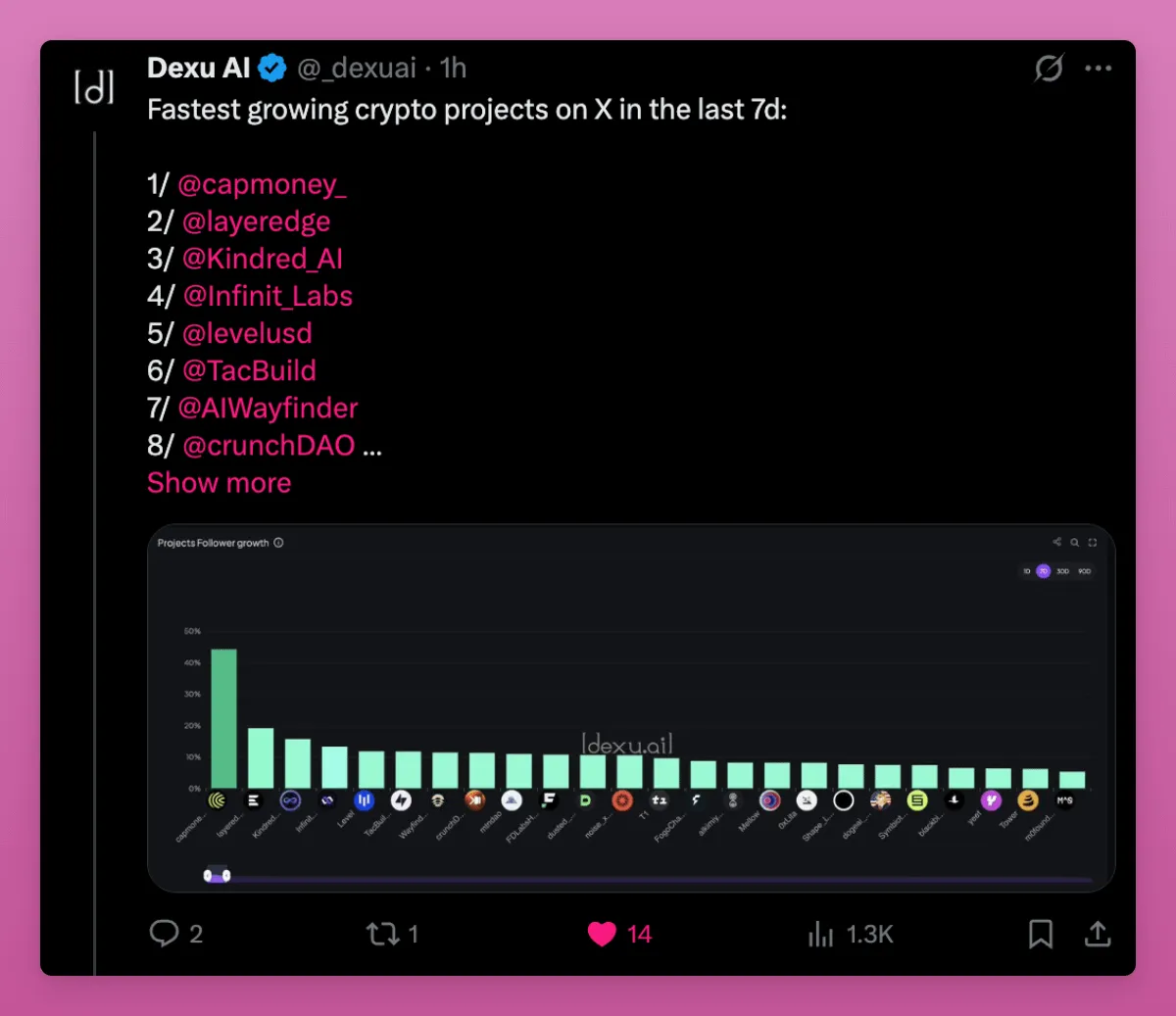Author: IGNAS , DEFI RESEARCH
Compiled by: Tim, PANews
Cryptocurrencies are currently completely governed by macroeconomic factors.
All I see in my X is macroeconomic analysis, not airdrop mining guides or meme coins.
As I write this, crypto and traditional financial markets remain at “extreme fear” levels (even after some tariffs are lifted).

Navigating the crypto space has never been more challenging, and as a content creator, I’ve never felt so deeply about my own shortcomings. I know my macro analysis is mediocre, but I still want to share it.
I agree with DonAlt: in today's crazy world, people haven't thought deeply enough about cryptocurrencies.
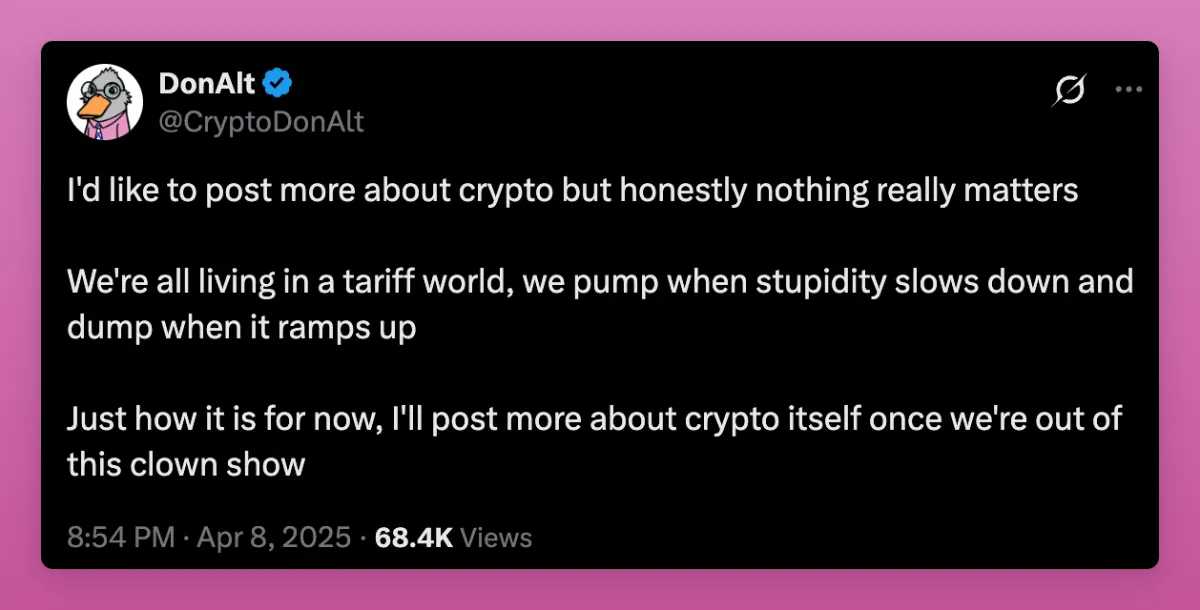
Unfortunately, if this does mark a shift in the world order and the end of the great debt cycle (as Dalio suggests), we will be facing an unstable macroeconomic environment for years to come.
However, in some relatively stable areas, attention will turn to dynamic developments within the cryptographic system.
The 90-day tariff suspension may also bring some opportunities.
Bitcoin: Bull or Bear?
In hindsight, I should have liquidated my position when I published my blog post in February, “Bull or Bear: What’s Next?”
I shared some Bitcoin on-chain data charts (below), and the market immediately turned from bullish to bearish. Don’t blame me, I, like most KOLs on X, can’t correctly predict the market direction.
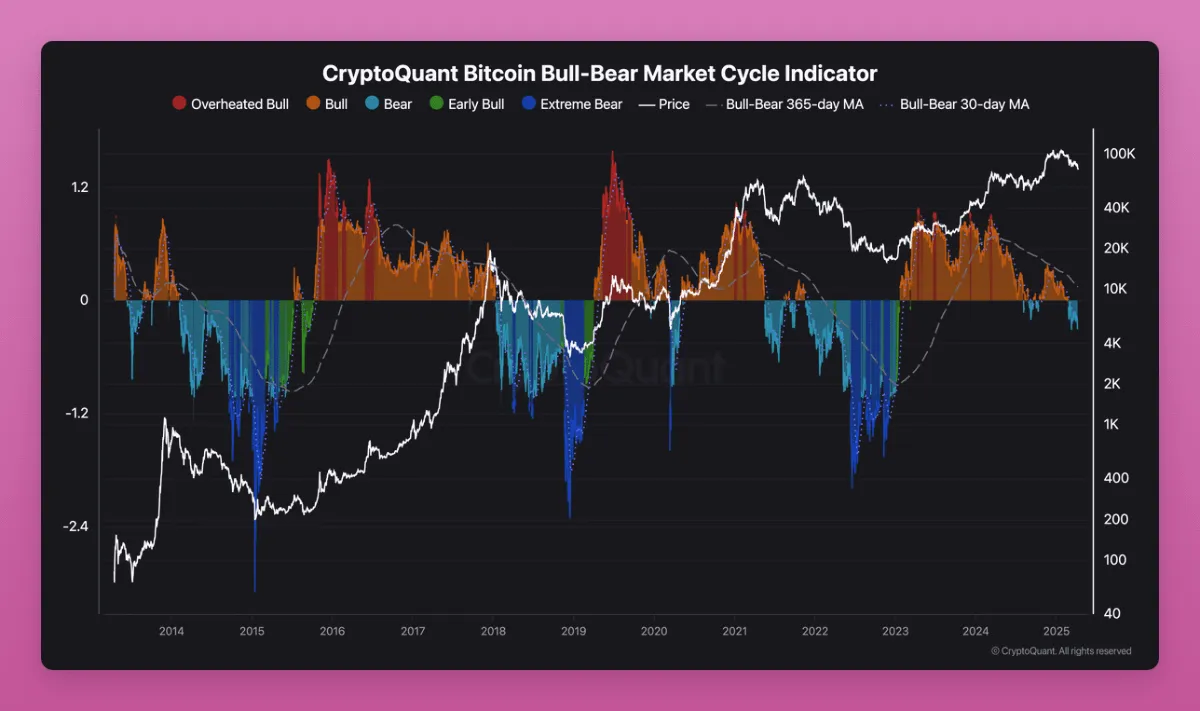
What I understand is that in a bull market driven by internal factors, the importance of on-chain data will exceed that of a bull market driven by external macro factors (such as the current bull market).
Bitcoin has emerged as a macro asset, with two main schools of thought arguing over its status.
- Is Bitcoin a risky asset like stocks?
- Is Bitcoin a safe haven asset like gold?
Many people have not yet fully realized that the major dilemma facing Bitcoin is that if it cannot establish its safe-haven asset attributes and remains highly correlated with the Nasdaq index, the current price will lose fundamental support. Once this characteristic of linkage with risky assets solidifies, institutional investors will lose interest in allocating to it.
In my article “The Truth and Lies of Cryptocurrency in 2025,” I described Bitcoin as an atypical safe-haven against macroeconomic uncertainty.
Bitcoin cannot be both digital gold and a risky asset at the same time.
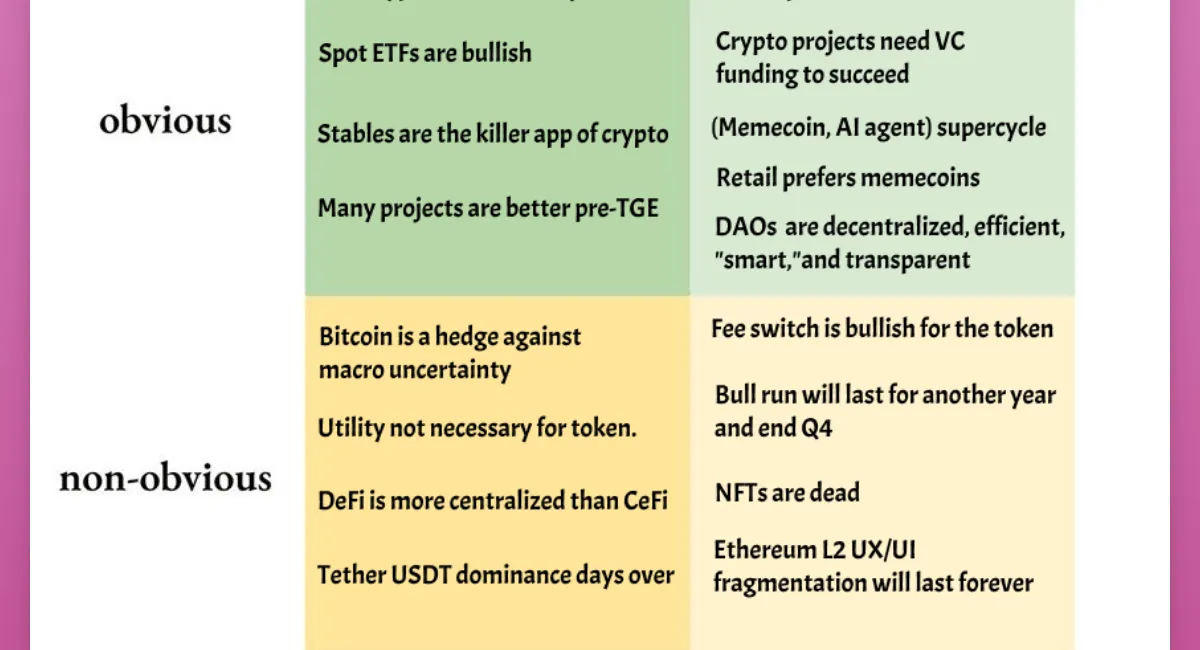
Bitcoin will reach $250,000 by 2025, and Ethereum will rise to $12,000.
BlackRock’s correlation research confirms this, and even Dalio, who was previously skeptical of Bitcoin, admits that Bitcoin is a “store of wealth”:
"In the early stages of a big debt cycle, money is 'hard money', meaning it is both a medium of exchange and a store of wealth whose supply is difficult to increase at will, such as gold, silver and Bitcoin. Cryptocurrencies like Bitcoin are now becoming a widely accepted hard currency because it is a universally accepted currency worldwide and has a limited supply. The biggest and most common risk of money becoming an ineffective store of wealth is the risk of a large increase in the issuance of money. Imagine if you had the power to create money, who would not be tempted to issue a large amount? Those who hold this power will always do so." - Dalio, "How Nations Go Bankrupt: Introduction and Chapter 1"
I highly recommend reading Dalio’s latest book, How Nations Go Bankrupt. In it, he argues that the United States is currently in a typical large debt cycle. Dalio believes that in the process of debt restructuring, a new world order also needs to be established.
This is the only article that provides an in-depth analysis of the current situation in the world.
In short: the US will print money, and other heavily indebted countries will follow suit. You can imagine what will happen to Bitcoin in this scenario.
Bitcoin seems to be more of a risk-on asset than gold (which is hitting all-time highs). I think those who view Bitcoin as a risk-on asset are selling it to those who view Bitcoin as a safe haven asset.
I really liked the part in BlackRock’s interview with Bankless where he mocked the crypto-native analysts who insisted that Bitcoin was a risk asset because they were trading Bitcoin based on macroeconomic indicators like unemployment data, non-farm payrolls, or the ISM manufacturing index.
Perhaps a simpler theory can explain the current trend of Bitcoin: it is purely driven by liquidity and excessive money supply. When money is tight, Bitcoin fluctuates like junk money; when the central bank's money printing machine is running at full speed, Bitcoin will crush all risky assets.
This is also the argument that crypto analyst Hayes continues to advocate.
To be honest, I expect Bitcoin to skyrocket because the fiat monetary system is being completely broken.
Ethereum: There is no worst, only worse
If we value ETH based on fundamentals like active addresses and fees, then a pullback to 2018 levels makes sense.
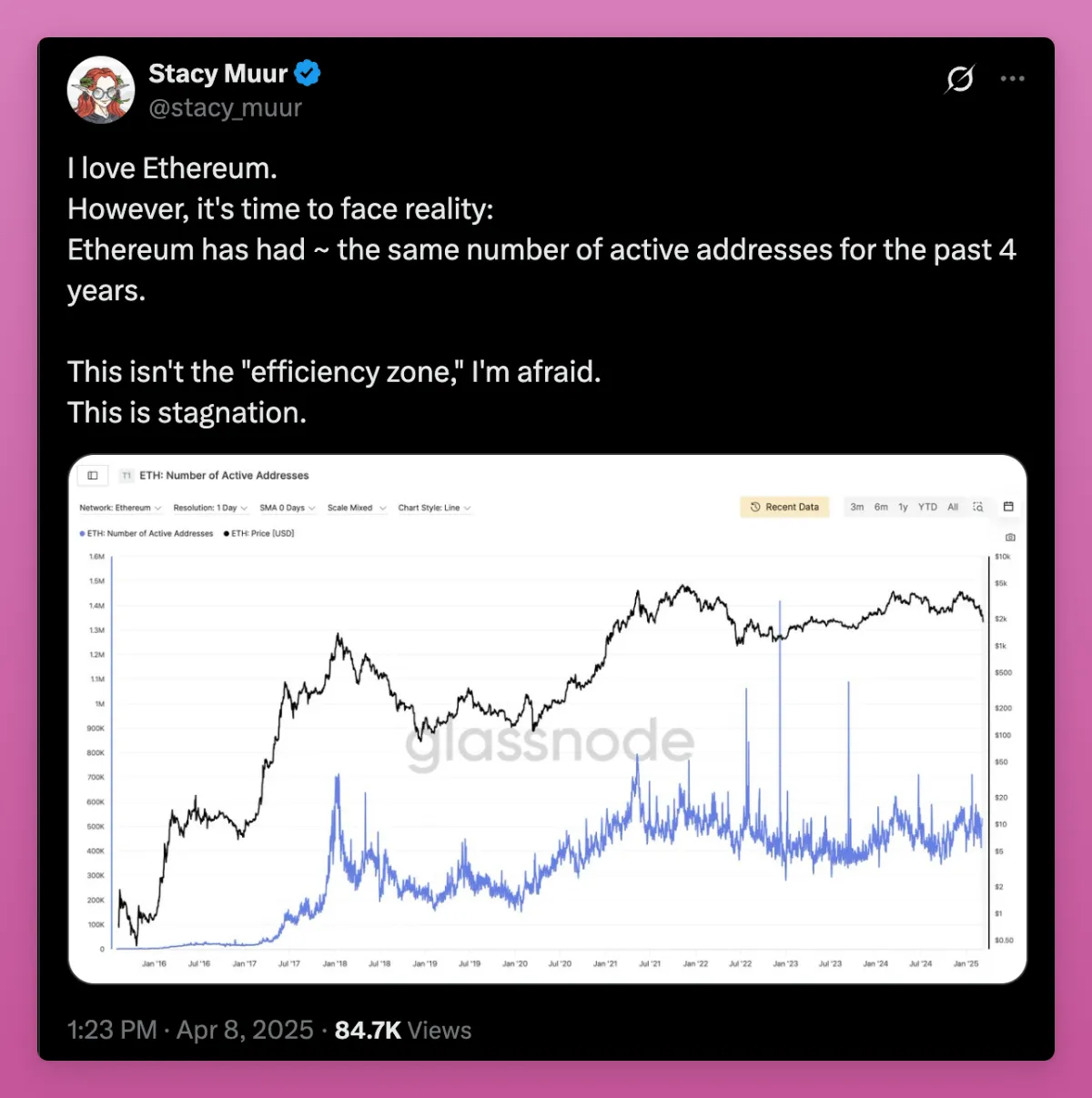
If we count the active addresses of each L2, we can see growth, but this is entirely due to the Base chain. Other chains such as Optimism and Arbitrum are stagnant.
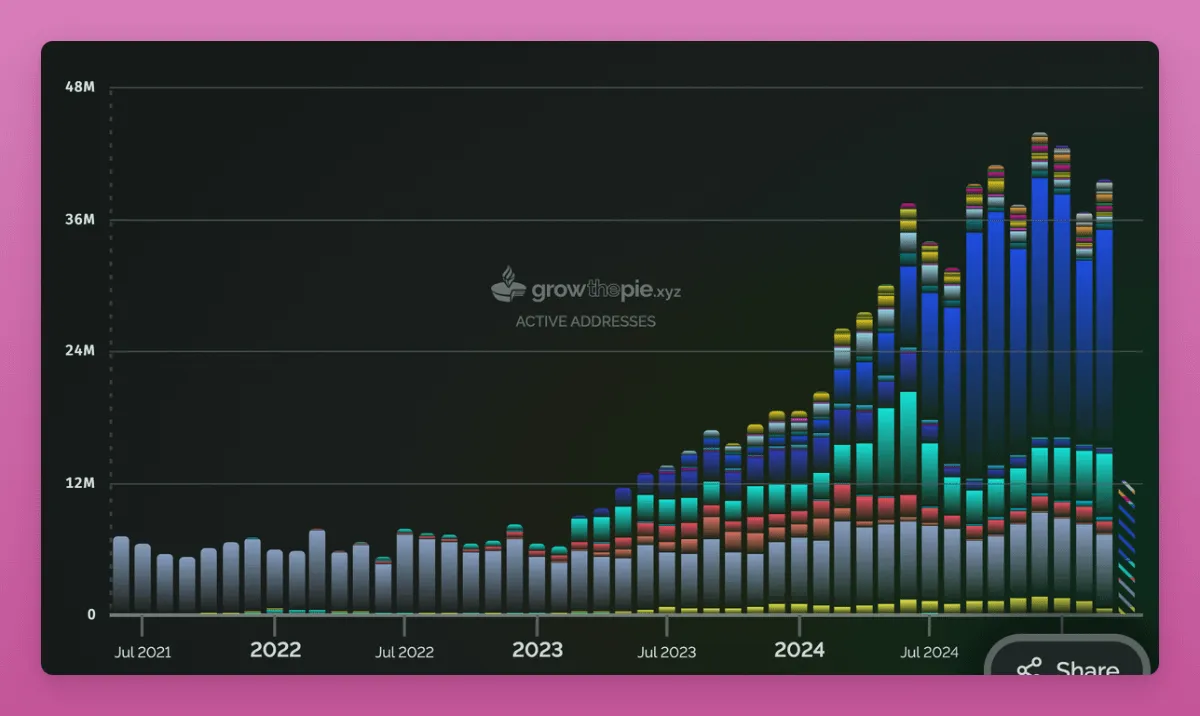
First, as I explained in this post, I do not consider GAS fees to be the only factor in assessing the value of an L1.

Rather than focusing solely on the fee-diverting effect of second-layer solutions on Ethereum and viewing it as a threat, it is better to view ETH as a productive asset:
- In the IC0 era, ETH was the universal currency for participating in token sales: the project's treasury was denominated in ETH. Ironically, this effect still has consequences today, as many old projects are still selling the ETH accumulated from fundraising that year.
- During the DeFi Summer, ETH is the base asset for mining various food coins and animal coins. For example, in the SUSHI/ETH liquidity pool, you need to provide ETH to mine SUSHI tokens.
- ETH was (and still is) the dominant currency during the NFT craze.
My DeFi investment maniac's strategy manual in the bull market is to bet on the L1 public chain as a productive asset: use SUI, STX, INJ, SOL and other tokens to participate in ecological mining to obtain airdrop tokens. Once the airdrop is obtained, it is immediately sold in exchange for the underlying L1 assets, and the process is repeated.
However, most of these first-layer blockchain projects have failed to successfully develop their ecosystems. Even if a few projects (such as STX and SUI) have made some progress, the token airdrop results of their ecosystems are not satisfactory.
The reason I bet on ETH is that Eigenlayer's re-staking mechanism will make ETH the most efficient productive asset in the history of blockchain: by re-staking ETH, not only can you get higher returns than simply staking, but you can also get a large number of airdrops from Eigenlayer ecosystem projects.
Eigenlayer failed. I thought Symbiotic might have a chance, but it doesn't matter now.
The bullish sign? The average cost price for Ethereum holders is $2,200, so most holders are losing money.
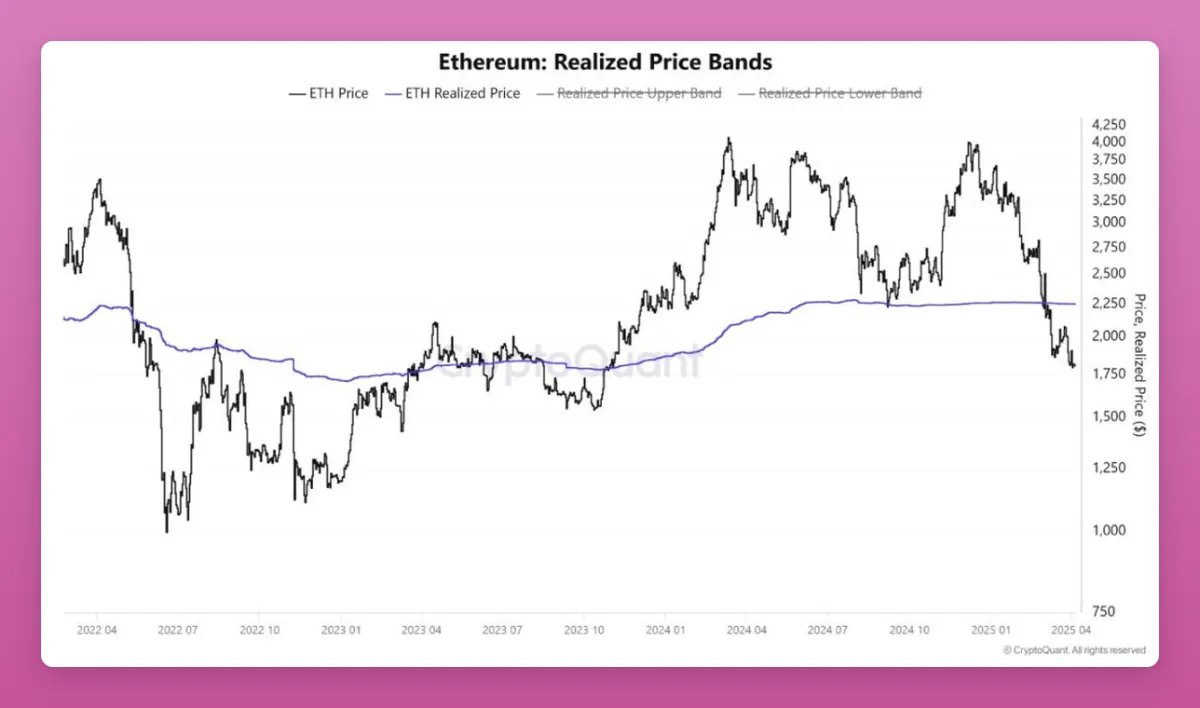
At present, ETH is still an asset with certain production attributes, mainly used as collateral in the DeFi ecosystem. However, in this round of market cycle, its production attributes are not as good as SOL, because SOL plays a core role in the Meme coin craze (as a medium of exchange and a means of value storage).
I think SOL is following the trend of ETH because the collapse of the meme coin has not yet been replaced by other narratives that can drive demand for SOL. However, due to the low market value of SOL and the high inflation reward, users can still get an annualized yield of 25% in Kamino's Multiply liquidity pool. Can anyone find me such a high yield in ETH?
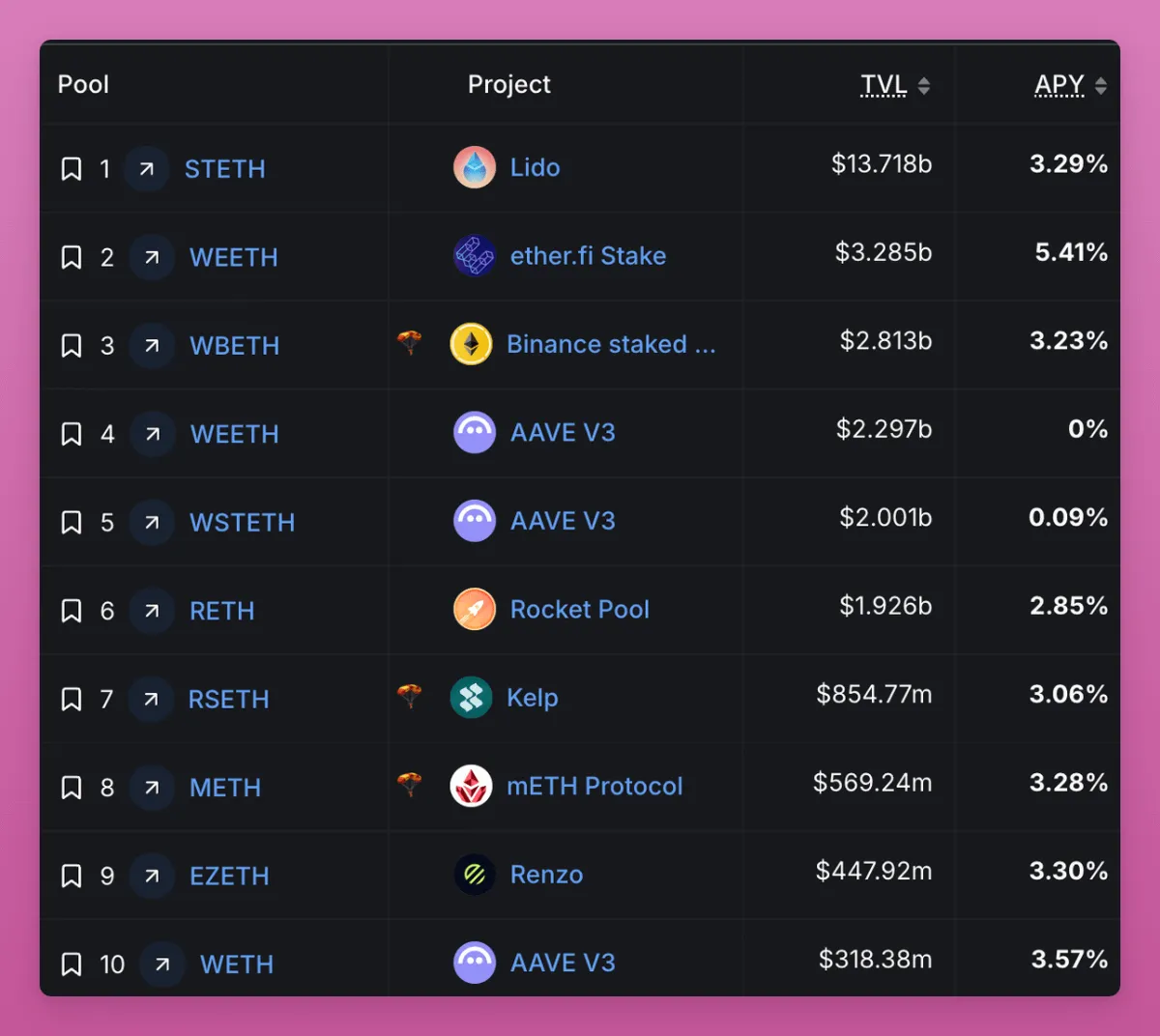
To reverse the trend of ETH requires:
- a stable macro environment that supports risk appetite and a favorable regulatory environment;
- Make ETH a more productive asset.
Changes in US regulations are good news for Ethereum and other Layer 1. These changes will attract more stablecoins, promote asset tokenization, and accelerate the overall adoption of blockchain technology.
But even if the prospects for asset tokenization on Ethereum (compared to other blockchains) are very optimistic, it does not necessarily mean that the ETH we hold will skyrocket.
Imagine if Tesla stock could be traded on the Ethereum chain, this would be a major boon to DeFi. Hundreds of billions or even trillions of dollars of assets in the traditional financial market can be used as collateral to lend stablecoins for daily consumption scenarios.
If Apple's stock can be freely traded globally through Uniswap, it will usher in a golden age for DeFi protocols (and their tokens). We can finally get rid of the current stage of dependence on internal circulation and leverage requirements. By then, the fee generation of platforms such as Aave, Fluid, Uniswap, etc. will increase exponentially.
- But what does this mean for ETH as a productive asset? Transaction volumes will undoubtedly grow, but the Ethereum Foundation is planning to drastically reduce fees for both layer 1 and layer 2 solutions.
- User asked: I wonder if the RWA asset will be paired with Ethereum or a stablecoin? But honestly, why would it be paired with ETH?
- Will transactions be conducted on L2 (such as Base) that does not distribute revenue to the L1 mainnet? Will the Ethereum Foundation force L2 to pay a share to L1?
- ......
Many questions remain unanswered.
RWA tokenization is the most bullish narrative among Ethereum bulls, but as Sam explains below, it won’t necessarily be a major driver of Ethereum price.
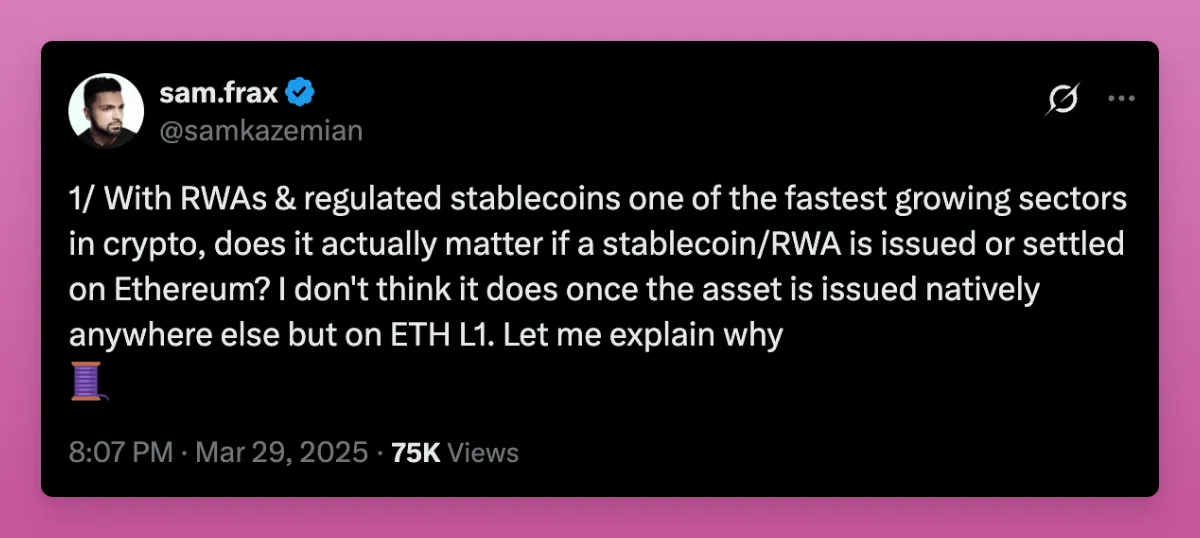
Currently, a number of emerging projects are entering the market following the trend of Ethereum's RWA tokenization and institutional adoption: such as Plume, Ethena, and Converge, a Layer 1 blockchain for traditional finance launched by Securitize.
Overall, I would like to see ETH become a more productive asset again. Low-yield collateral that continues to depreciate is not enough to support the market value growth of a $200 billion asset.
Current productive assets
Which assets are currently most productive?
Hyperliquid (HYPE)
There are two main reasons for choosing HYPE:
- Hyperliquid generates more fee revenue than Solana and Ethereum, and uses that revenue to buy back HYPE tokens.
- The HyperEVM ecosystem is emerging, with HYPE as its core token.
The HyperEVM network is full of forked DeFi protocols, and these projects are preparing to issue their own tokens. Our strategy is very clear: identify the most promising protocols and deposit HYPE tokens into them.
Most decentralized applications focus on circular leverage strategies, which typically work like this:
- Pledge your assets to HYPE LST.
- Use it as collateral to borrow assets or mint stablecoins.
- Use the borrowed assets to repeat the cycle.
This could be risky if something goes wrong in the operation steps. Therefore, I took a conservative strategy: participating in Nansen interactions by staking LSTs or using the Hyperliquid native platform. (Nansen is about to airdrop!)
Since decentralized applications are emerging and constantly changing, by the time I publish this article, the situation may be different.
To be honest, I plan to swipe the eco-airdrop and then sell it to get more HYPE. Although this is not a good idea.
Initia (INIT)
Although it has not yet been launched, I think there will be good mining profit opportunities once the project goes online.
As I explained in my previous post on “Five Hot Upcoming TGEs”, Initia’s “Holy Liquidity” mechanism allows users to earn rewards in two ways: users can either stake INIT tokens individually or stake protocol-approved INIT-X liquidity pool tokens (these LP tokens need to be paired with INIT tokens), both of which distribute rewards through the Delegated Proof of Stake (DPoS) mechanism.
Built-in liquidity is a good Ponzi token economic mechanism, which requires 50% or more of INIT tokens to be used as paired tokens for all tokens in the ecosystem. These LP tokens must pass the governance whitelist review.
However, I am cautious here: INIT's "native liquidity" model is similar to Berachain. Although the yield on Berachain has been very impressive, if you don't know what you are doing, those cunning liquidity providers may make you lose all your money.
Study the ecosystem and seize the opportunity to exit.
Sonic (S) vs. Ronin (RON)
Liquidity mining activities are being carried out in both ecosystems:
Sonic's 200 million S tokens marketing campaign will end in June 2025. Despite the overall market crash, as the core asset of the ecosystem, S is more stable than Bitcoin and outperforms Ethereum and SOL, which is the characteristic of productive assets. However, June may be a worrying time for S holders.
Ronin will offer a total of $3 million in rewards across multiple liquidity pools, with yields of approximately 75% for USDC/RON and ETH/RON trading pairs.
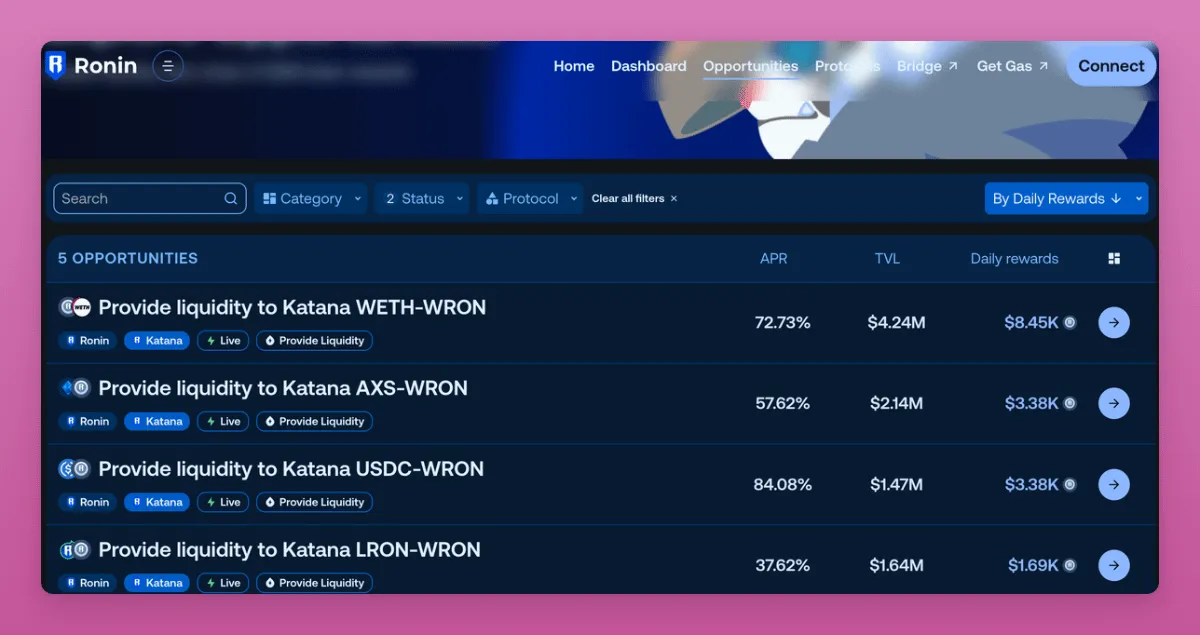
And Bitcoin, surprise?
Earning income on Bitcoin is the holy grail that everyone pursues, but it comes with a compromise in security: you need to deposit Bitcoin into a second-layer protocol or other third-party address controlled by multiple signatures.
Nonetheless, protocols like BTCFi, like Lombard Finance, have pushed their TVL to $1.7 billion without attracting widespread attention, surpassing platforms like Pancakeswap, Raydium, and Rocket Pool.
You can participate in the yield farming of multiple protocols at the same time through the Lombard Vault, and receive yield and airdrop rewards from up to 6 protocols at one time.
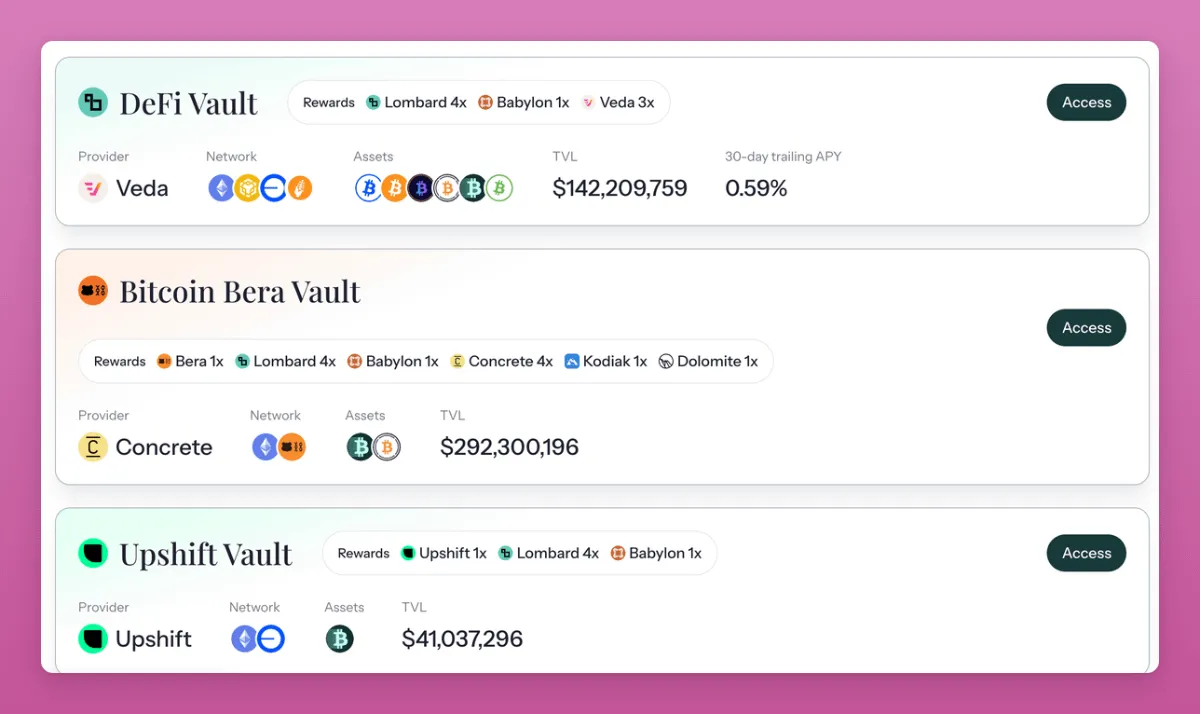
Other easy-to-use income earning opportunities are provided by the Xverse and Bob L2 platforms.
For example, you can stake BTC into Babylon through Solv Protocol and obtain the liquid staking token solvBTC.BBN.
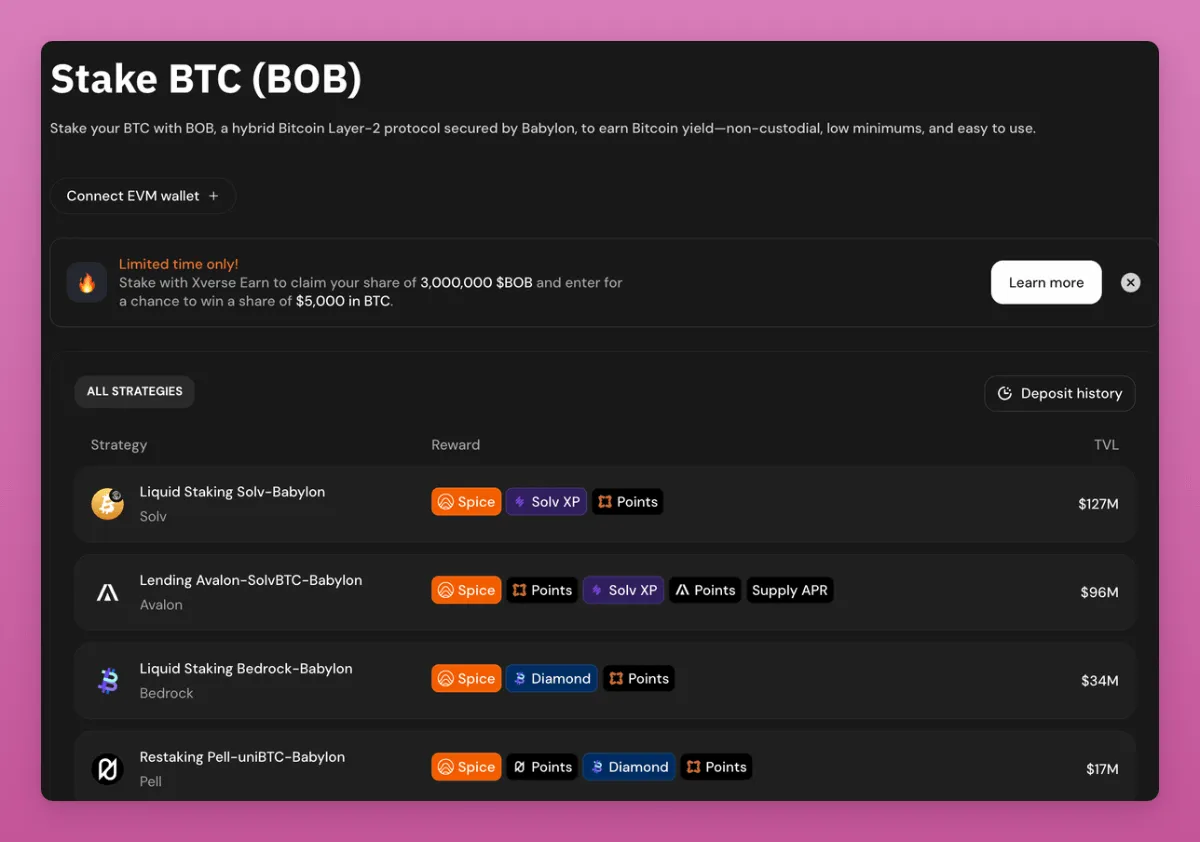
The current annualized rate of return for each project is unclear, but as I write this article, Babylon’s ecosystem token BABY has been listed for trading, with a liquid market value of $282 million and a FDV of $1.2 billion.
By comparison, EIGEN's current market capitalization is $183 million and FDV's is $1.3 billion.
Perhaps the restaking narrative has not died, but is just quietly unfolding in the Bitcoin ecosystem.
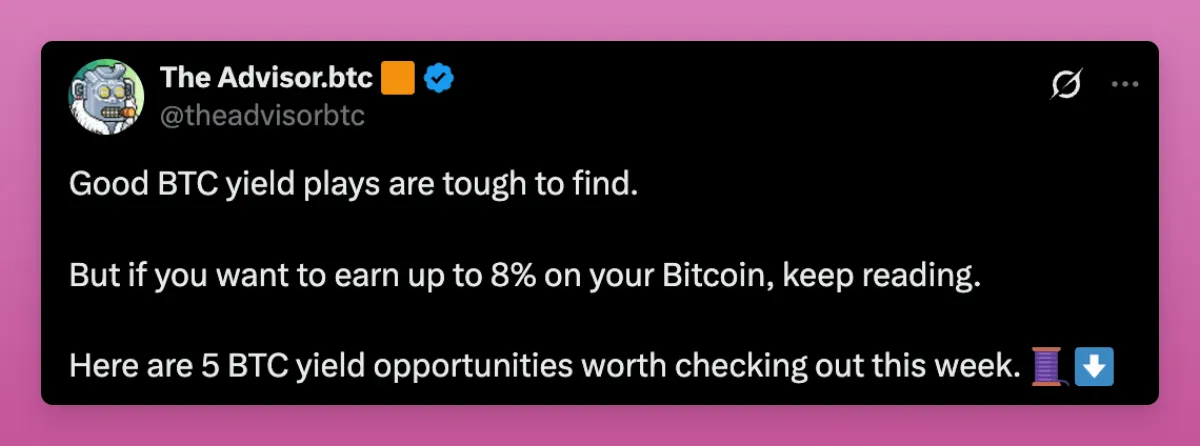
Two Bad Precedents in Token Economics
PancakeSwap
PancakeSwap is currently working closely with Binance, focusing on the joint TGE event as Binance is committed to promoting its Web3 wallet.
This cooperation is a major boon for Pancakeswap, whose trading volume has made it the second largest decentralized exchange after Uniswap. Pancakeswap’s weekly fee income reached $11.26 million, only $2 million less than Hyperliquid.
However, this did not push up the price of CAKE.
To address this issue, CAKE is transforming its token economic model from the original "revenue sharing and community-driven decision-making" mechanism to a team-led "buyback and destroy" model.
Here comes the problem: PCS, Magpie and StakeDAO protocols that adopt the governance meta-aggregator business model have encountered Rug.
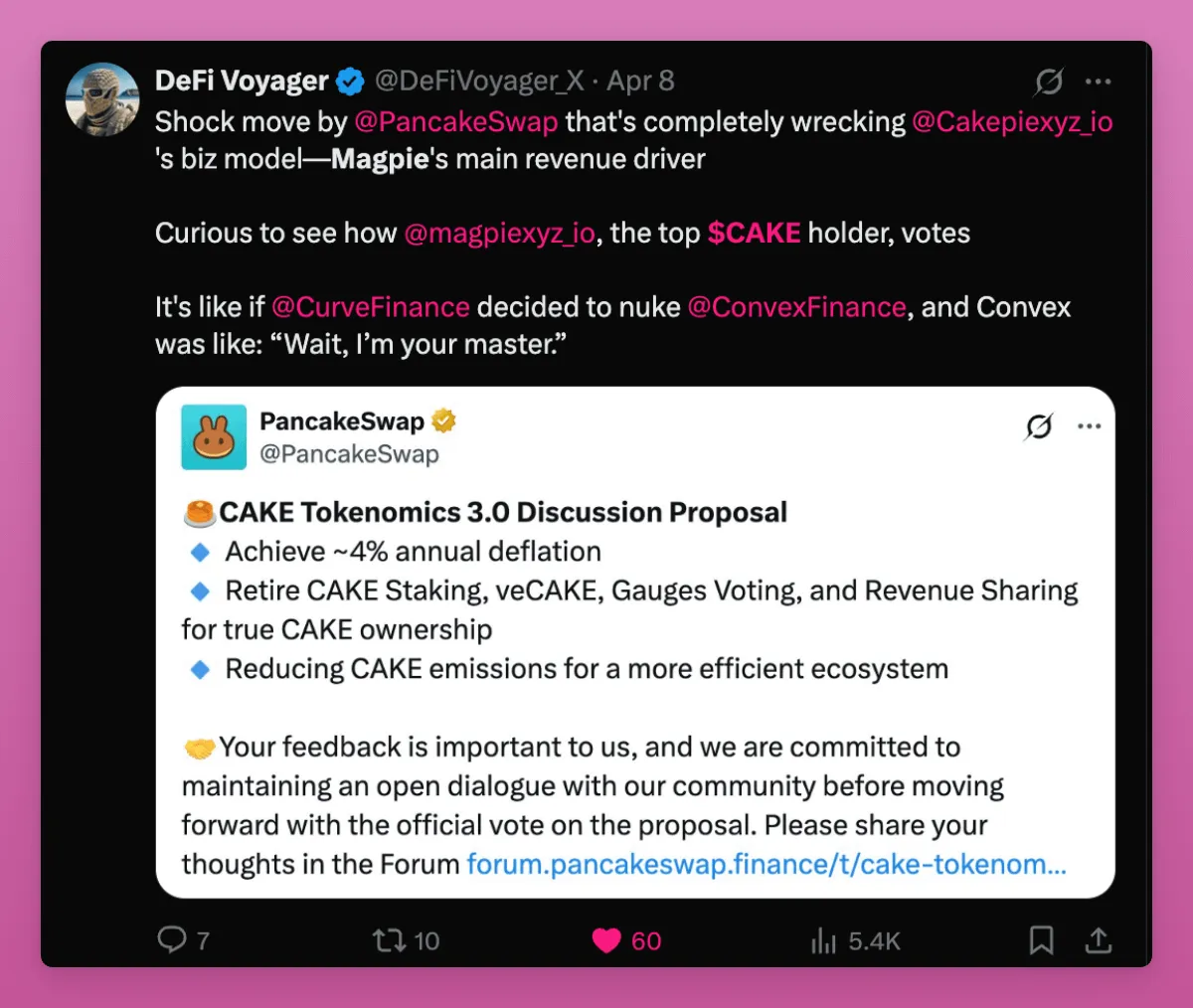
This is similar to the relationship between Convex and Curve, where the veCRV token is used for governance and reward release, but to simplify the process and consolidate the benefits, the CVX token runs as a top-level protocol.
This is a precedent that investors need to consider before investing in similar meta-governance protocols.
Crypto.com
Compared to PCS, Crypto.com is in a much worse situation.
Simply put, Crypto.com did not destroy 70% of the BURNT tokens in 2021, and then announced a partnership with Trump Media Company to launch a crypto ETF that includes CRO itself.
Crypto.com took scams to a whole new level. Unfortunately, the industry seems to have forgotten about this, but I will never forget it. Crypto.com will always remain on my list of the most hated companies.
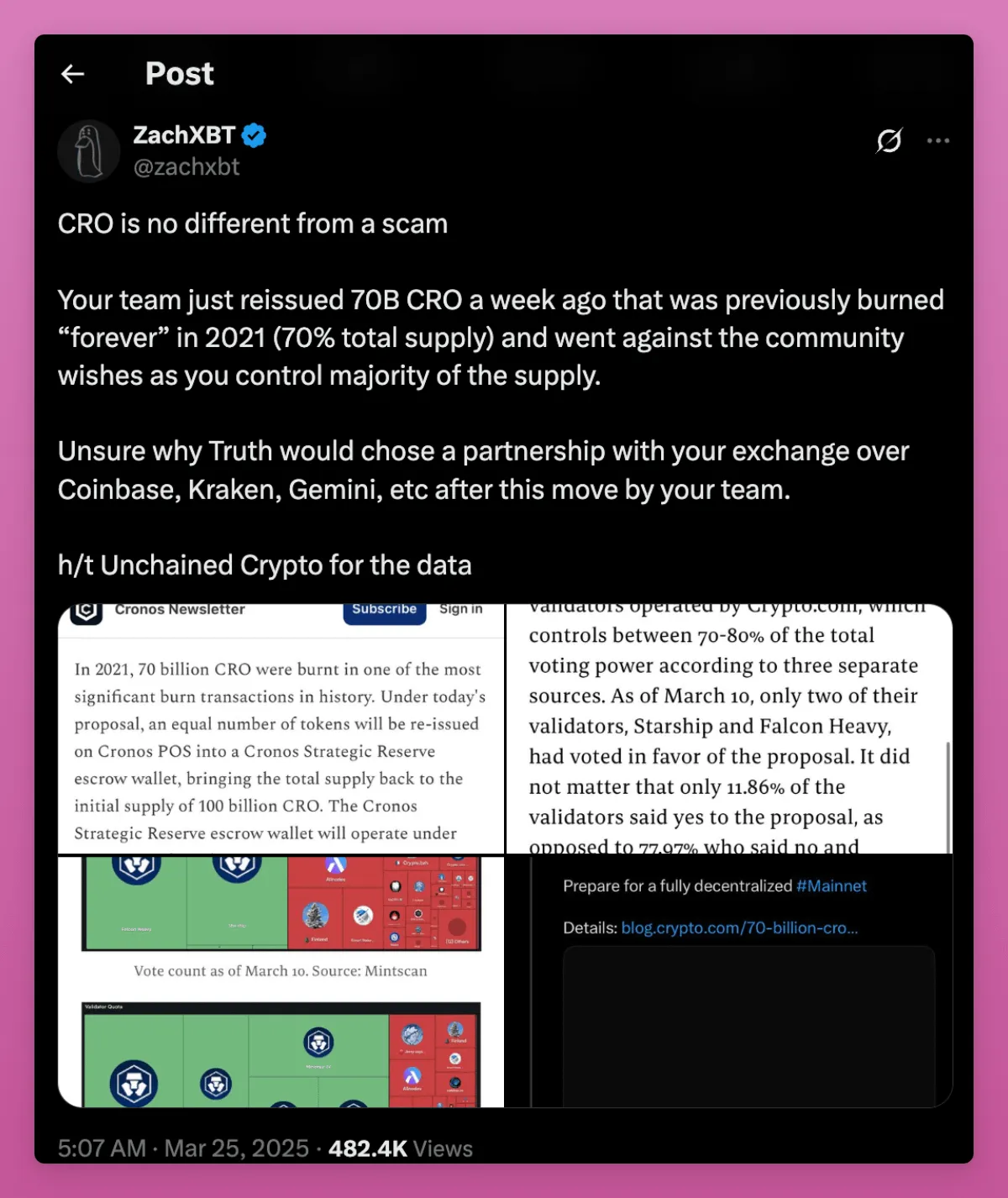
Both projects set a bad precedent for the industry. Token economics must be predictable to be worth investing in. No wonder people only trust Bitcoin.
If the total cap of 21 million Bitcoins is lifted one day, please be prepared for a massive sell-off.
The old DAO is dead, long live the new DAO
I think the old DAO model is undergoing a revolution, but many are missing out on the fun due to the current turbulent macroeconomic situation.

In a few months, I expect many DAOs will start experimenting with different voting models and making adjustments to their token economics.
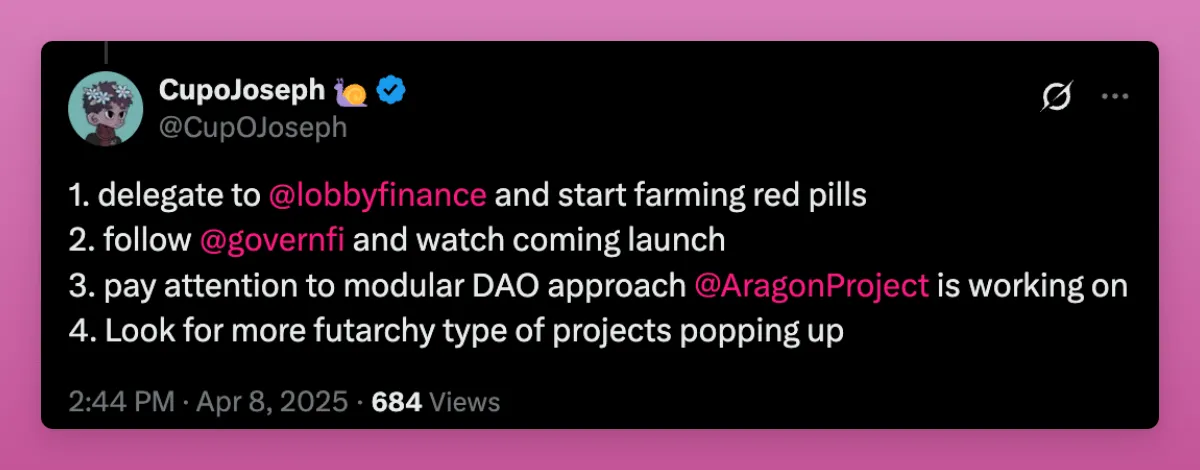
Lobbying (buying votes) in the DeFi space will become an increasingly serious problem as DAO tokens lack appeal without real revenue sharing or staking rewards.
Aragon allows DAOs to be launched as modular entities, enabling decentralized management of governance rights through plugins with different functions.
To be honest, Futarcy is the most exciting project.
It uses prediction markets to guide decision-making, aiming to improve efficiency and reduce the flaws of the "1 coin = 1 vote" model.
Arbitrum DAO considers launching a staking mechanism:
Two prediction markets were created:
- Market A: What will the price of ARB be in six months if the staking mechanism is implemented?
- Market B: What will the price of ARB be in six months if the staking mechanism is not implemented?
ARB token holders can bet on both markets. If the predicted price of ARB tokens shown by market A is higher than that of market B, the staking mechanism will be used.
This could revolutionize the way voting in DAOs is done.
After recognizing all this and the Lobby Finance incident on Arbitrum, Arbitrum leadership released a new "Arbitrum Future Vision".
To address inefficiencies, a core group of the Arbitrum Foundation and Offchain Labs will now handle the majority of decision-making.
This also follows a growing trend of BORGs (Budgeted, Aligned, Scoped, Governed) entities, especially Lido.
Both Lido’s BORG and Arbitrum’s new vision seek to solve the same core problem: DAOs, while decentralized, are chaotic, inefficient, and lack a clear enforcement structure.
In short, Arbitrum’s attempt at true decentralized governance has failed, and teams like Lido have taken back control.
What happens next?
When the current government can change the direction of cryptocurrency with just one post, it becomes extremely difficult to predict what will happen next.
However, I am closely following the market performance of the Babylon token, the progress of Initia’s TGE, and how Ethereum’s Pectra upgrade will improve the current user experience.
Trump’s decision to postpone additional tariffs for 90 days has eased market pressure, so I believe that all project owners will seize this window of opportunity to launch tokens, launch mainnets, and so on.
It’s time to let all our panic go for these three months.
To that end, I also plan to share my insights on emerging and promising crypto projects. There is so much to research!
